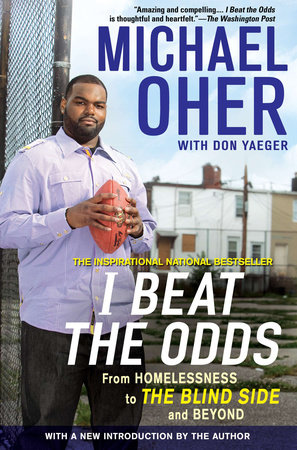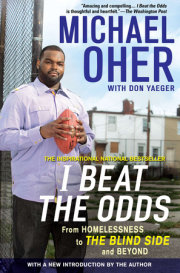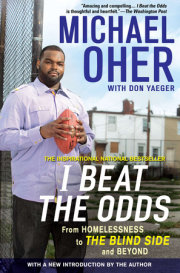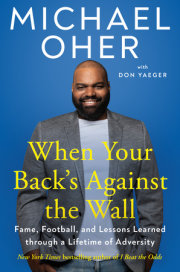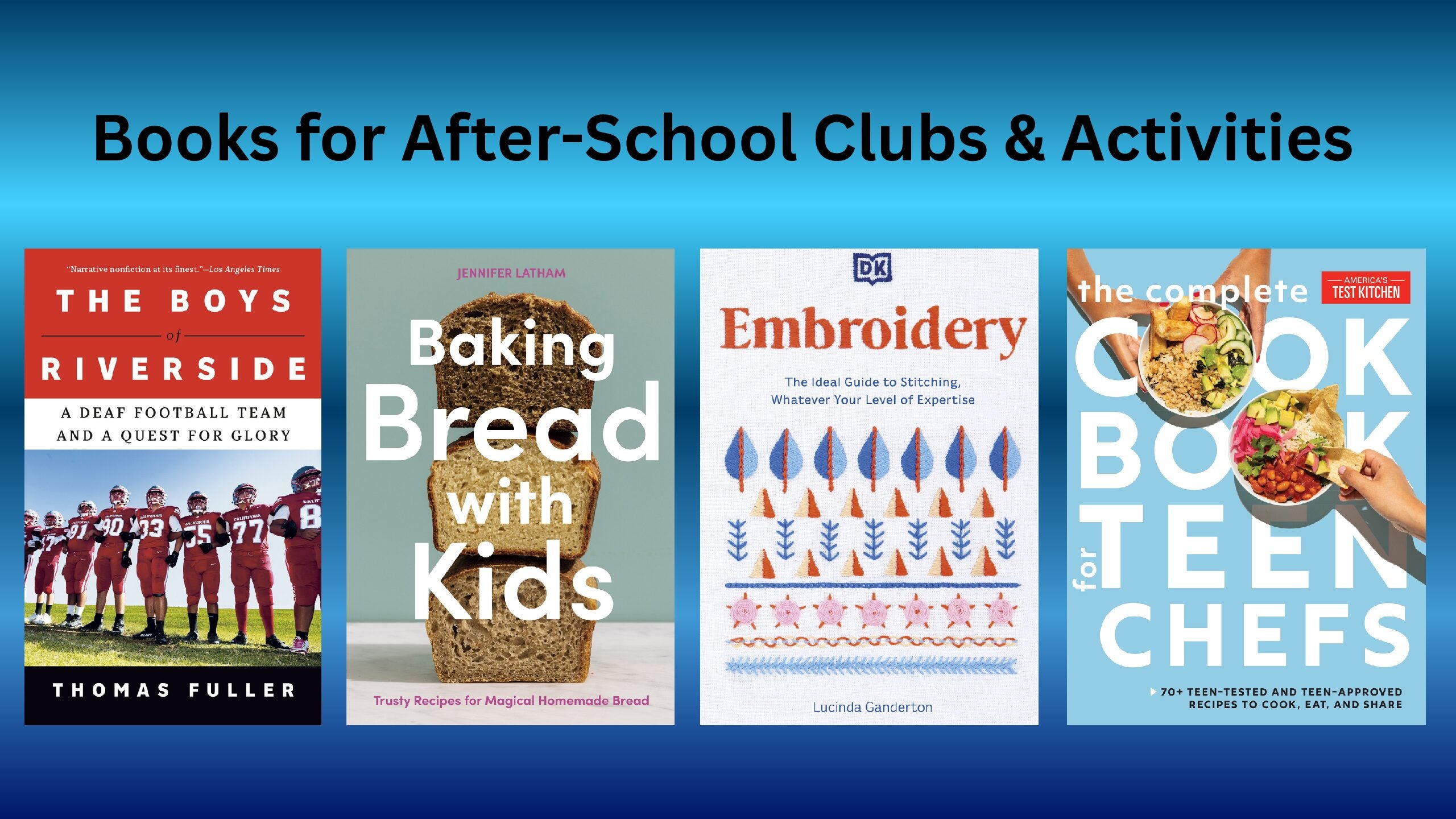CHAPTER ONE
You’re not poor if you know where your next meal is coming from. That’s one of the first lessons I learned growing up. The lines were pretty clear: There were people who had food, and there were people who had to scrounge. Most of the time—way more than most of the time—I was in the second group. I think about that now, whenever I sit down to dinner at a nice restaurant or open the refrigerator in my own home, which I always make sure is full. If I pass a homeless person on the street, I try to be pretty generous with what I drop in their cup because I know how it feels to be sitting in their spot. It’s crazy now, as I look at my career and the opportunities I have, to think about how I was living just a few years ago. I had to beg for anything I needed; now I have everything I could possibly want. But before my happy ending, there was a very sad story.
***
I think it is important, before I talk about my life when I was little, to explain how it was when I remember it best. It’s going out of order a bit, but I think it will help put everything else in context. To understand my life, you have to understand my world.
Like most kids, when I was younger I didn’t really understand that my life was not normal. It wasn’t until I had a chance to see how other people lived that I realized that the way my family lived wasn’t the way everyone else lived. A child can only under-stand what he or she sees daily—that’s what seems normal. And until I saw another way of life, the things that I was surrounded by seemed totally normal to me, so the problems with it didn’t stand out in my mind.
But from the time I was almost eleven years old to the start of high school, I called Hurt Village my home. There were some foster places mixed in, but Hurt Village was always what I considered home. The name fit—Hurt Village. It seemed like everything and everyone there was hurt, broken, depressed, beaten down. And by that point, I was finally old enough to understand that it was a pretty bad place to be and a pretty bad way to live. It was all I had, but I knew I wanted something better. In some ways it looked like every other housing project in every city in America: rows and rows of identical brick buildings that were two or three stories high, busted screens and broken windows, a place empty and boarded up every few units, rusty handrails on cracked concrete steps, broken toys and broken lawn chairs in the little patches of grass outside each door. Even the air smelled greasy, dirty. It was the kind of place that depressed you instantly if you took a wrong turn and ended up driving through it. But most outsiders never drove through it because it was also the kind of place you took a U-turn in the middle of the road to get out of if you ended up there accidentally.
There were some empty lots where the kids played sports during the day and where drug deals probably went down at night, but they were my favorite places to be. Up in the front of the neighborhood was a park—not the kind with swings or a slide or any-thing, just four soccer goalposts that probably didn’t even have nets in them most of the time we lived there. Toward the back of the neighborhood, closer to our house, was the Green Lot. There was a blacktop for basketball (where we always played by street rules, which are not as formal—or consistent—as league rules), plus a couple of open, grassy areas there; my best friend, Craig, and I laugh now about the fact that the areas probably weren’t meant for kids to play in. But that didn’t matter to us because in the neighborhood, we kids came up with our own set of rules for the fi elds: The smaller lot was the Regular Season Field and the larger one was the Play-Off Field.
We followed the NFL’s schedule, so it was always exciting when we made the switch over to the big fi eld in January. If there were older kids playing on the Play-Off Field, though, we would wait until they cleared out. A bunch of eleven- and twelve-year-olds can’t really challenge seventeen- and eighteen-year-olds for playing space. A lot of times, though, we would play with the older guys—some even twenty-one or twenty-two years old. I think they enjoyed running around and knocking into people just as much as we did. We played full-tackle football, but there wasn’t much blocking; everyone pretty much played receiver, running out once the ball was snapped and hoping you could catch it if the quarterback threw it your way. Each team’s QB would get to the count of ten to throw the ball or run with it. Anything beyond ten Mississippis would qualify as delay-of-game. I don’t remember that we ever pretended that we were one NFL team or another—we were our own team, I guess: the Hurt Villagers.
When we were still kids, a made-up team was something great to be a part of, but as we all became teenagers, something else started to appeal to a lot of boys more than football. There were gangs and everything that goes with them: gang turf, gang thugs, gang fights, gang wars. The Vice Lords and the Gangster Disciples were the two big ones I remember. If you saw big cars roll up with the leaders inside, you would scramble to get inside the house unless you wanted to risk getting caught in the crosshairs. All-out shooting matches were pretty rare, but I do clearly remember one time watching a baby get shot in the midst of an argument.
The most scared for my own physical safety that I ever was as a kid was when I was eleven years old, and the gangs had an all-out shoot-out in the middle of the neighborhood. We were just playing outside when the guys in red (the Vice Lords) started shouting at the guys in blue (the Gangster Disciples)—or maybe it was the other way around. I didn’t pay attention once they stopped yelling and the bullets started flying instead. We just all ran into the nearest house, kept away from the windows, and prayed that the walls were thick enough to keep any stray shots out.
But that was my neighborhood and most of the people there didn’t know any other way of life. They knew it wasn’t great, but they didn’t do much to change things. People who were born there usually never left except to go to another project—or to prison. Life in Memphis ghettos didn’t really have its ups and downs. It was pretty much the same—all downs all the time. There would be exciting moments like shoot-outs or arrests, but as far as the big picture—the way people lived and died—that didn’t change much from generation to generation. And, unfortunately, that’s probably the biggest problem for anyone who wants to get out.
The history of public housing in Memphis has always been bad. At first, the developments were racially segregated by law. Because so many slums had grown up along the river during the Depression, the downtown area was getting very run-down by the end of the 1930s. The city decided to demolish a lot of those neighborhoods with plans to put real homes instead of shacks in their place. The goal was to make those houses and apartments safer and cleaner places for the poor residents of Memphis—and almost all the African Americans in Memphis were poor.
After World War II, the city put up a couple of different neighborhoods just for black people to live in. There were places like Castalia Heights, which at the time was called the “South’s No. 1 Private Negro Apartment Development.” It provided low-cost homes for more than four hundred families. There were also places like LeMoyne Gardens and Klondyke Arms, which were built during the 1940 and 1950s. The goal was to keep black families away from the white ones, so the poor white housing projects were separate. There were a lot of those, too, but at the time there were still laws that restricted where in the city black people could live. For most of the 1960s, there was a halt on all public housing, so no new projects were built then. But the population kept growing, and many discrimination laws were still in place, which meant a lot of black families literally had nowhere to go.
Racial tension was a big problem in the city, and the housing situation was a major part of it. Groups like the Black Panthers eventually got involved when other protests didn’t bring about any change. They staged “live-ins” where they would occupy housing units to bring attention to the shortage of available places and the bad conditions of the existing ones.
Hurt Village started out as one of those housings projects that was originally built for poor white people in the 1950s. But that changed as Memphis did. The unfair housing laws finally were defeated as the schools were integrated, and by the 1970s, there wasn’t a white person to be seen in Hurt Village. They’d all moved out as the new laws allowed black families to move in. I guess when you’re that poor, you hold on tightly to your identity because it’s all you’ve got, so the neighborhood went from one kind of segregated to another.
Some of the other projects stayed just as they had been built. LeMoyne Gardens has always been a black neighborhood, first by law and then just because that was who continued to live there. But it changed, too. At first, it had been designed to be a place where lessons on hygiene and job skills and parenting were offered as part of a community outreach effort. But as time went by, many of the hardworking families were able to get out and buy their own homes. They were usually replaced by people who weren’t as motivated to make good life choices. By the 1980s, LeMoyne had to be put under a curfew and “foot patrols” by police officers who would walk around all night because of the drug deals and high crime. It was that way in a lot of places, black neighborhoods and white ones. The people who really cared and worked for success almost all eventually left for better neighborhoods as opportunities opened up for them, and the people who replaced them in the old neighborhoods didn’t have the same sense of pride or vision.
The crime problem kept growing and finally, in the late 1990s, someone decided that in order to fight the crime problem in Memphis’s housing projects, they’d knock most of them down and spread the residents all over the city to new areas. The idea, I guess, was to break up the “problem people.” Many condemned homes were fixed up. Others were taken down completely. By the end of 2001, more than 3,500 apartments in eleven of the biggest projects had been closed. Robert Lipscomb, the executive director of the Memphis Housing Authority, said in an interview that the goal was to “deconcentrate” the population of poor people and help move them to better neighborhoods. He explained, “I think if we eliminate some of these problem structures, we will also reduce crime.”
It was a nice thought, but all it managed to do was to spread crime to new areas.
The first HOPE IV neighborhood, which is what the city called the new effort, opened where LeMoyne Gardens used to be. It got knocked down to build a mixed-income neighborhood with some middle-class homes and condos and some public housing apartments. That started a trend that you can see all over the city now. Hurt Village ended up as part of that movement. It got bulldozed not long after LeMoyne did. In fact, a lot of the places where I lived growing up have been knocked down and replaced with shiny-looking buildings and beautiful middle-class homes with shutters and big porches. But for a large chunk of my childhood, one of the ugliest and most dangerous parts of the city was where I felt the safest because it was better than the alternative. At least my family was there . . . most of the time.
My mother did her best. I have to give her that much. When she was sober, she worked hard to give us a good home and look after us. The problem was that she wasn’t sober much. When she got back into her old habits, life at home kind of fell apart. We didn’t always have a roof over our heads. Sometimes we’d get kicked out of one place and just wander over to another. If one of us kids had a friend who would let us stay longer than just a night or two, we’d sleep there until my mother got another place, and then we’d eventually make our way back to the new place to live with everyone else again. Once, seven of us kids lived in a car with her for about a month. We piled on top of one another to sleep, kicking and hitting one another trying to carve out a little space of our own.
We managed to stick it out, though, because we all loved one another. Neighbors used to comment on how attached the Ohers were to their family, and they were right. We truly were loyal to one another. I loved my brothers and sisters so much that I was always determined to look out for them and wanted to live as near to them as I could. I loved my mother so much that it hurt even more when she would relapse with her addiction, because I knew how much damage she was doing to herself and to our family.
Social workers would come over for visits, to evaluate how we were living, how my mother was doing, what the condition of the house was like. They would ask us questions and make notes on their clipboards. They wanted to make sure we were still going to school and not getting into trouble. We told them whatever we thought they wanted to hear because we didn’t want to end up separated again. That had happened before, and I think we all hated it too much to risk it again.
Copyright © 2012 by Michael Oher. All rights reserved. No part of this excerpt may be reproduced or reprinted without permission in writing from the publisher.

